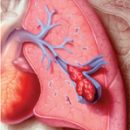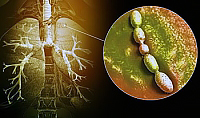What is Empiama pleura? How diagnostics is carried out? How treatment is carried out by the speech? Answers to these and other questions you will find in the article.
Content
 Empiam of pleura - purulent inflammation of the pleura - arises as a result of the abscess breakthrough into a pleural cavity, infection of serous effusion when inflammation of light or injury of the chest.
Empiam of pleura - purulent inflammation of the pleura - arises as a result of the abscess breakthrough into a pleural cavity, infection of serous effusion when inflammation of light or injury of the chest.
Microbial flora with emphas can be diverse: pneumococci, streptococci, staphylococci. In the breakthrough of the abscess reporting with the bronchus, piopneumoxes occurs - cluster in the pleural cavity of pus and air. Empiama pleura can be accumulated and spilled.
In emphasis of the pleura noted signs of pronounced intoxication: high body temperature, shortness of breath, tachycardia, cyanosis of mucous membranes, chest pain. The lag at the breath of the affected side is revealed, with percussion - the dullness of the pulmonary sound, with auscultation - weakened breathing and voice trembling. At the time of breakthrough abscess to the pleural cavity arises shock.
With radioscopy, the transparency of the pulmonary fields is lowered, and with a significant cluster of the fluid, there is a complete darkening and displacement of the shadow of the heart in a healthy side. On the side of the lesion, the shadow of the diaphragm and the pleural sinus are not detected.
Empiama pleura can be complicated by the breakthrough of the waste through the chest wall, osteomyelitis ribs, bronchiploral fistulas.
The anti-empty of the pleura is established on the basis of a clinical picture and X-ray examination data. In doubtful cases, pleural puncture with the study of content is shown.
At the beginning of the disease, massive antibiotic therapy are prescribed. Antibiotics combined with sulfanilaminamide drugs. The repeated puncture of the pleural cavity with the removal of the contents and the introduction of antibiotics is shown. If punctures fail to achieve cure, permanent drainage is introduced through a small incision in the seventh-nine intercostal. Pnu remove active aspiration or create passive outflow. Drainage is removed after stopping the pus. Through drainage you can rinse the pleural cavity with antiseptics or antibiotic solutions. Permanent aspiration is necessary in patients with popurnum-pains to remove air and pus.
With a long-term empieve that does not give in conservative methods of treatment, resort to surgical intervention (opening of the pleural cavity, removal of purulent contents and tamponade of purulent focus). In the case of the formation of residual purulent cavities with thick walls from connective tissue, pleurectomy or thoracoplasty is shown. This intervention leads to the weavest of the chest wall, contact with parietal and visceral leaflets of Plevur, the battle of them and the elimination of the residual cavity.









